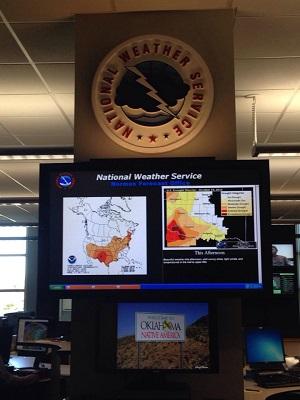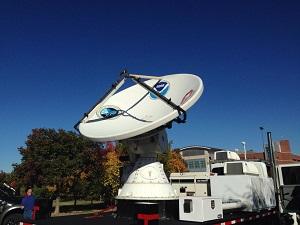
When I was a kid, I fell in love with the weather. There has always been something about the study and science behind it that has always fascinated me. I used to stand in front of the big screen TV and pretend to be a meteorologist standing in front of the big green screens. On November 2, I attended National Weather Festival and got an upfront view of the Storm Prediction Center in Norman, Oklahoma.
It was absolutely incredible to see "behind the curtain" and get an up close look at the National Weather Service. After getting parked and taking a few moments to completely weather-geek out, I was finally emotionally stable enough to walk over to the booths, events, and speakers.
I saw a lot of really interesting things, but some of it stood out. Here are my four favorite parts of the day:
- Oklahoma University research students are currently flying model planes into the atmosphere to take readings. It’s an alternative to weather balloons, which are almost never returned to the National Weather Service. The tiny planes are made of Styrofoam for now and read the atmospheric conditions. The goal could be to build larger and more study planes for a fleet of “hurricane hunter” type devices. These small scale planes could eventually be used to read conditions ahead of severe storms in a hopes to better warning times and give people more notice of approaching tornadic systems.

- "Tornado sirens" or outdoor warning systems are still a big topic of conversation in the weather community, especially given the events in Oklahoma this past May. I was surprised by the amount of people who live in an area where major tornadoes touch down that don’t know that the NWS has no control over when they are sounded and how they are sounded. These are all controlled by local emergency management operation systems and each office has different rules for when they are sounded.
- Research is currently being conducted on the dissemination of information via social media accounts when there is severe weather hitting. The NWS is looking specifically at tweets during the Moore, Oklahoma to see how quickly information (good and bad) spread. Do rumors spread faster on social media or are people pretty good at vetting info before sending it out? This could signify a shift in using social networks as a more legitimate means of getting information to the public.
- (During a Q&A session with forecasters I received this answer to my question about the overall goals with issuing warnings) Eventually the National Weather Service wants to be able to predict storms in a more specific area. Watches are issued for large swatches of counties across the states and then warnings themselves are issued in polygon shaped areas across these counties. Even though tornado activity in recent years have had a lot of media attention, it still stands true that most places that are placed under a "watch" never actually receive a warning. In a perfect world, the NWS would be able to issue watches in a more specific zone.

In the end, the lead forecasters at the National Weather Service want you, as the general public, to educate yourself on how severe weather works. My opinion is that part of the reason why people don’t respond the way they should is because they don’t understand what forecasting is all about. We (the public) complain when the NWS issues a tornado watch and nothing happens, meanwhile, the meteorologists sitting in the Storm Prediction Center breathe a huge sigh of relief because the parameters didn't come together the the way the models predicted they would.
In the weather world, a day that ends with you saying “they got us all amped up for nothing - bunch of morons don’t know what they are talking about” is the best kind of day for the meteorologists in the Storm Prediction Center.

